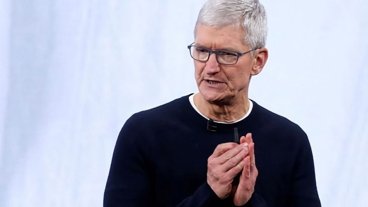Notes of interest from Apple's Q3 2011 conference call
Apple's iPhone and iPad products continue to send the company to even greater heights, as handset sales were up 142 percent year over year, and the iPad grew 183 percent from 2010. Its $28.57 billion in revenue was a record-breaking quarter.
Participating Tuesday's conference call were Apple Chief Operating Officer Tim Cook and Chief Financial Officer Peter Oppenheimer.
Apple's iPhone business
iPhone sales were up 142 percent year over year, despite the fact that a new model was not released in the quarter. Sales also crossed the 20 million milestone for the first time ever.
More than double IDC's estimated growth for the rest of the smartphone market.
91% of Fortune 500 are using or testing iPhone as a primary device, including major corporations like Nestle, Dow Chemical, Glaxo Smith Kline, and Comcast. In addition, 57% of all Fortune 500 are similarly deploying or testing the iPhone.
Recognized revenue from iPhone sales was $13.3 billion, up from $5.3 billion, or an increase of 150 percent.
Though sales were strong year-over-year in all segments, Asia/Pacific was particularly strong, almost quadrupling year-over-year.
Apple continues to increase its iPhone production capacity and by the end of the quarter was available at 228 carriers in 105 countries.
Apple ended the quarter with about 5.9 million iPhones in channel inventory, which falls within their target range of 4-6 weeks.
Added 42 new carriers in the last quarter. Sequential improvement was due to emerging and developed markets. China, Brazil, Mexico and the Middle East were said to be major contributors.
"We are really beginning to see the fruits of our labor in these markets," Cook said.
Looking forward, Cook said expanding the iPhone to new carriers is a major focus for the company. "There are still great partners out there to do business with, so we're obviously out working new relationships."
On iPhone activations, Cook said Google's recent numbers are difficult to compare because Apple sold over 33 million iOS devices in the June quarter.
"Our numbers are very straightforward, they're transparent, and they're reported quarterly," Cook said.
Cook cited recent data from ChangeWave that showed Apple has the greatest customer satisfaction and those who plan to buy a smartphone in the near future prefer the iPhone.
On the prepay market, Cook said "We know that we need to play there in order to have the kinds volumes we'd like to have." The company has "a lot more to do" in expanding channels for the device.
Apple's iPad business
The iPad grew 183 percent year over year to reach sales of 9.25 million. iPad sales exceeded total iPod units in the quarter.
Apple continued to sell ever single iPad they could build.
Launched iPad in 36 additional countries during the quarter, ending with availability in 64 countries.
Recognized revenue from iPad sales was more than $6 billion, up from $2.2 billion.
Apple ended the quarter with about 1.05 million iPads in channel inventory, which is below their target range of 4-6 weeks worth.
47 percent of Global 500 companies are testing or deploying iPad. 86 percent of Fortune 500 are deploying or testing the iPad, up from 75% during the previous quarter.
In total, more than 220 million iOS devices have been sold through the June quarter.
Cook said some iPad purchases are inevitably made instead of a Mac, but he believes more customers are buying an iPad instead of a Windows-based PC.
Said it's been a "frenzy" as customers want to get an iPad 2, but he feels confident in the company's ability to ramp up production and meet demand.
Cook said Apple expects iPad sales to see significant year over year growth in the next quarter, though they don't share specific numbers.
"Last quarter, we sold more iPads in K-12 than we did Macs," Cook said. "To do that in just five quarters is absolutely shocking. We never would have predicted this."
He said the iPad has a "universal appeal" in many different markets, from consumers to schools to government.
On media consumption, Cook said if you talked to 10 different people, they'd likely give you 10 different reasons that they love the iPad.
Apple's Mac business
Mac sales were 3.95 million, up 14 percent from 3.47 million a year ago.
2011 represents a new June quarter record for Mac sales.
Growth was more than four times IDC's recently published forecast for the overall PC market, Oppenheimer said.
Performance was particularly strong in Asia, up 57 percent year over year.
Apple's iPod business
iPod sales continued their steady decline in the most recent quarter, slipping 20 percent year over year to 7.54 million.
iPod touch accounted for half of all 7.5 million iPods sold during the quarter.
Apple TV is doing well, Cook said, but he doesn't want anyone to believe that it's becoming a major product. "Right now it's still a hobby status, and we're continuing to invest in it because we think there's something there."
He said the new A4-powered Apple TV, released late last year for $99, was a wise transition for the company to make.
Apple's regional business segments
International sales accounted for 62 percent of the quarter’s revenue.
The company saw the greatest gains in the Asia Pacific region, where sales spiked from $1.8 billion in 2010 to $4.7 billion in 2011.
"China was very key to our results," Cook said. Greater China sales were up over six times, with revenue of about $8.8 billion for the year.
"This has been a substantial opportunity for Apple, and I firmly believe we are just scratching the surface right now," Cook said. "I believe there is an incredible opportunity for Apple there."
Apple's retail business
Revenue from Apple's retail segment rose 36 percent to $3.5 billion on higher volume sales of Macs and iPads.
Apple opened 4 new stores during the quarter to end with 327 stores. Average revenue per store rose roughly 20 percent to $10.8 million.
The stores hosted 73.7 million visitors during the June quarter, up from 60.5 million during the year-ago quarter.
Apple's personal set-up program within the stores got off to a strong start, with Apple having set up over 2 million total Macs, iPhones, iPods and iPads during the quarter.
Looking ahead, Apple plans to open 30 new stores in the September quarter alone, including the first store in Hong Kong.
Apple's next (Q4 2011) fiscal quarter
Apple's guidance for next quarter calls for revenue of $25 billion and diluted earnings per share of about $5.50.
Gross margin is expected to be about 38 percent. Operating expenditures are projected to be 2.725 billion, with a tax rate of about 24 percent.
Oppenheimer said the company expects to see year over year increases in sales for its Mac, iPhone and iPad products. iPod units are expected to decline.
He also alluded to a "future product transition" that will affect the company's fall quarter. He attributed that, along with this fall's launch of iCloud and other services, to more conservative than usual guidance for the next quarter.
Oppenheimer said lower gross margins are expected to be due in part to a different product mix, as well as a full quarter of the company's back to school promotion.
Cook said NAND, DRAM, LCDs, batteries and optical drives are in a "very positive supply situation currently." Hard drive supply, however, is constrained, and those prices are expected to drop less than other components.
Oppenheimer said Apple saw benefits in the warranty and phone support elements, as well as "some settlements" that the company had, which helped the company's gross margins in the third quarter of fiscal 2011.
 AppleInsider Staff
AppleInsider Staff










 Malcolm Owen
Malcolm Owen
 William Gallagher and Mike Wuerthele
William Gallagher and Mike Wuerthele
 Christine McKee
Christine McKee
 William Gallagher
William Gallagher

 Marko Zivkovic
Marko Zivkovic









